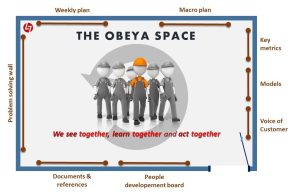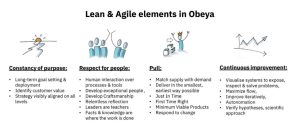“Creating an Efficient and Inspiring Obeya Room”


“Strategy without tactics is the slowest route to victory. Tactics without strategy are the noise before defeat!” — Sun Tzu
Introduction
Vacations often start as a wonderful idea and then eventually end up being a nightmare to manage. Often overlooked, a lot of thought and brainstorming goes into perfectly organizing touring plans. The lack of know-how on how to plan a trip often reflects during “unseen hurdles” on a vacation. With a little bit of preparation and effort in planning the vacation, travellers can overcome 90% of the difficulties they may face during a trip.
Read More: https://bit.ly/BalancedScorecard1992
Objective
An Obeya room is a space where all the necessary information about work can be displayed. It’s also a place where people can discuss regularly. The Obeya can be called many different things, depending on the company or team. Some organizations may call it a control room, whereas others may refer to it as a war room. However, the definition still applies regardless of the label put on it. The purpose is to ensure project success and shorten the PDCA cycle.
 What is the iObeya then? The iObeya is an online visual management tool based on the Obeya management method. Because it’s virtual, its use and operation may vary slightly, but its principles remain the same. The organization can find the same components in an iObeya room as in a physical Obeya room. With a digital iObeya room, the users have the opportunity to customize each element of the room.
What is the iObeya then? The iObeya is an online visual management tool based on the Obeya management method. Because it’s virtual, its use and operation may vary slightly, but its principles remain the same. The organization can find the same components in an iObeya room as in a physical Obeya room. With a digital iObeya room, the users have the opportunity to customize each element of the room.
Once you read this blog, you will understand, what is Obeya Room, how it is linked with Hoshin Kanri and X diagram, why it is important for any organization and how to implement it effectively in your organization.
Read More: https://bit.ly/DOJOCentre
Definition:
Efficiency (Cl 3.7.10): Relationship between the results achieved and the resources used.
Effectiveness (Cl 3.7.11): The extent to which planned activities are realized and planned results are achieved.
Read More: https://bit.ly/5SSteps
Detailed Information
What is Obeya Room?
“Obeya” means “Great Hall” or “Big Room” in Japanese and originates from the production of the Toyota Prius in the 1990s. Since then, this method has been used on many projects and is particularly useful for having an overview of multi-project programs. Today this method is even more relevant as it has transitioned online with the iObeya tool.
 An Obeya Room can help break down silos. Silos exist in workplaces, often for good reasons. They house experts in specific areas who work well together to accomplish specific functions. The issue for leaders is interlocking the efforts of these experts into a cohesive, successful whole.
An Obeya Room can help break down silos. Silos exist in workplaces, often for good reasons. They house experts in specific areas who work well together to accomplish specific functions. The issue for leaders is interlocking the efforts of these experts into a cohesive, successful whole.
Obeya is a form of visual management. When combined with a systematic meeting structure it becomes a powerful management system. Management will display critical objectives. For instance, in a Marriage function planning may include planning for the venue, invitation of guests, deciding the food varieties, etc. This allows a management team to quickly assess performance to plan. Consequently, problems become visible. Moreover, because a meeting commonly includes a cross-functional team an Obeya and meeting structure enable horizontal alignment. This facilitates rapid communication around problems to solve and how to solve them. It helps in an unprecedented level of collaboration, transparency and speed of decision-making to make any program a success.
Read More: https://bit.ly/HoshinKanriPolicy
Why it is Important?
In any industry, whenever any big project is planned (policy deployment, new product development: APQP-5 Phases, localization, supplier upgradation, etc.), a systematic approach is required. But in the majority of the organizations, the projects fail/are delayed owing to the following reasons
- Meaningless strategic planning sessions and follow-up documentation ends up gathering dust
- Trying to push a hundred projects simultaneously and nothing gets done
- Getting stuck in firefighting mode as a result of “operational miscommunication”
- Long, stale management meetings that seem to add little value, and everybody knows it
- Siloed departments that barely cooperate or even communicate
- Increased KPI steering by senior management in an attempt to gain control over what’s happening in the organization
- Stating people are the most important asset, but no one experiences it that way!
- Adopting and transforming new ways of working, like Agile from the outside, but sticking to the old habits from the inside!
Read More: https://bit.ly/DailyWorkManagement
To ensure that the top management can steer the big projects effectively and efficiently, the organization must take care of the following aspects.
 To make difficult trade-offs to optimize limited resources in support of the strategy, and Alignment using a framework that provides team focus on a common mission.
To make difficult trade-offs to optimize limited resources in support of the strategy, and Alignment using a framework that provides team focus on a common mission.- Better alignment between teams and purpose
- More effective meetings
- Better insights and decision making
- People development
- Trust and collaboration
- Rewarding
Read More: https://bit.ly/PDCASDCA
How to Implement it?
The ultimate goal of these principles is not simply to be able to apply Obeya but to create the conditions for a successful organization. Many of the Obeya principles are common sense, and the Obeya serves as an instrument to help you put them into practice through its visuals, rhythm and routines.
The 5 key steps include
- Have a well-defined goal (for each aspect)
- Break the goal down into secondary goals or milestones
- Identify process parameters that will get us to the goal
- Display BOTH the Result and Process parameters
- All measures must show the desired/target condition against the actual. This way abnormality surfaces and the PDCA improvement cycle begins
Example:
- Suppose a heavy-weight person has a goal of becoming Thin (Losing Weight)
- So, what must be measured…The weight lost? But the goal is not specific enough so let us re-define our goal – “Lose 15 Kg in 6 Months”
- But that still does not help with our Obeya display…We must break the goal down further into specific milestones (secondary goals)
- So, this could be “Lose 2.5 Kg every month”
- Does this alone suffice? NO….this is only a result parameter
- we must ALSO measure the process parameters that are going to get us that result
- So, we could also measure for example:
- Time spent on the treadmill daily (say against a target of 1 hour)
- The calories of food intake daily (against a target of fewer than 1500 calories)
Read More: https://bit.ly/KaizenMasaakiImai
 Frequency of Measurement: It will be determined by the following aspects
Frequency of Measurement: It will be determined by the following aspects
- The speed of System change: The more rapid the change, the more frequent the measurement
- The system response time to change: How long does it take for a change in the process to be reflected in the result (process performance)
Some of the key questions that can be asked to understand the efficacy of the Obeya room are as follows
- Can we see the strategic goals and how the things we contribute to them?
- Are we exposing problems that are on our path to achieving those goals, or do they remain hidden?
- Are we trying to achieve the goals, or are we trying to improve our system?
What is Achieved by Setting up an Obeya:
- Awareness of problems is maintained in “REAL” time
- Getting people together- enhancing quick decision-making and rapid action
- Opportunity for team members to voice concerns and collaborate
- Accelerated Team member development – Provides the opportunity for developing leadership
- Eliminates ad-hoc responses without root cause measures
- Leveraging expertise and support from members from diverse fields
- An appreciation for the right things
Read More: https://bit.ly/QualityCircle
Industry Challenges:
- How often the senior management team is consistently involved in ensuring the effectiveness of the Obeya Room?
- How often the status is LIVE or it is just updated to fulfill the expectations of the interested parties like top management, customer, auditors, etc.?
Read More: https://bit.ly/DifferenceCoachingMentoring
References:
ISO 9001: 2015
ISO 9002: 2016
ISO 9004: 2018
IATF 16949: 2016
Industry Experts
This is the 179th article of this Quality Management series. Every weekend, you will find useful information that will make your Management System journey Productive. Please share it with your colleagues too.
In the words of Albert Einstein, “The important thing is never to stop questioning.” I invite you to ask anything about the above subject. Questions and answers are the lifeblood of learning, and we are all learning. I will answer all questions to the best of my ability and promise to keep personal information confidential.
Your genuine feedback and response are extremely valuable. Please suggest topics for the coming weeks.

Recent Posts
Recent Comments
- Bhavya Mangla on Fear Begets Fear: Tame the Beast Within
- OnlyWikis on Fear Begets Fear: Tame the Beast Within
- Bhavya Mangla on What is the key difference between RPN (Risk Priority Number) and Action Priority (AP) -FMEA?
- Bhavya Mangla on What is the key difference between Cp and Cpk?
- Devendra Negi on What is the key difference between Cp and Cpk?
Thanks so much for the update
You are most Welcome
Thanks Amara for your response and going through it.